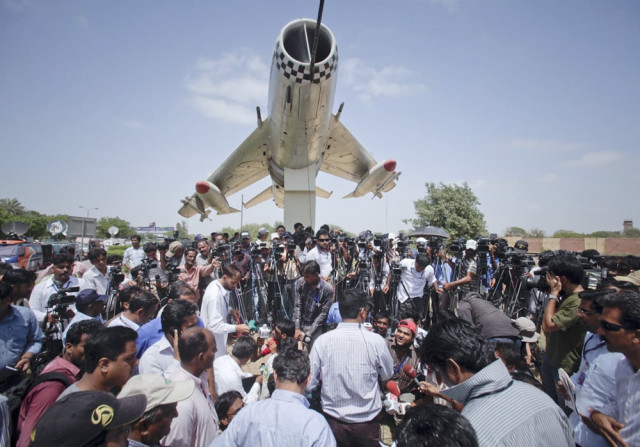
The Pakistan Navy does not believe that the attack on its airbase had anything to do with Osama bin Laden’s killing in Abbottabad on May 2, given the fact that Sunday night’s attack was the third on the navy, with two attacks on navy-owned buses that took place on April 26 and April 28, a week before the death of the al Qaeda leader.
A senior navy official told The Express Tribune just one day before the attack that threat levels at naval bases and cantonments remained at an all-time high, despite weeks passing by since the bus bombings.
“Every day we get a new alert. In fact we’ve been told to keep our guns close by since it was likely that a gun and bomb attack on the pattern of what we saw in 2009 on the GHQ may take place,” he had said.
Naval personnel were instructed to carry guns everywhere inside their base and homes in a break for normal policy, when they would have just keep weapons in the store rooms of their base.
“All standard operating procedures were being followed religiously,” the officer said, which included unscheduled timings of vehicles leaving the base, an increase in the number of checkpoints, and gunmen at the gates of naval installations.
However, the intelligence was not specific enough to say when and where exactly the attack would happen.
Inside job?
Previously, the navy was focusing its investigation into the bus attacks on possible involvement of Baloch separatist groups. In light of the attack on the Mehran naval airbase on Sunday night, however, naval intelligence is now taking the involvement of Tehreek-e-Taliban Pakistan and al Qaeda more seriously.
However, there had been no significant breakthroughs in the investigations of the bus bombings, background interviews with senior officials revealed.
There appeared to be a split between the leads followed by senior counter-terrorism officials in the Sindh Police and those pursued by naval officials.
Police officials insist that the attacks could not have happened without at least one navy officer or sailor being involved but naval officials reject that possibility, saying that no evidence supports this hypothesis. The navy has denied the police access to some of its personnel for questioning.
A senior police official said he had no doubts that someone in the navy had given minute-by-minute updates to the terrorists holding the remote to the improvised explosive device (IED) planted outside the base. “This became clear when the second attack on the navy took place outside PNS Mehran when an unscheduled bus left the [adjacent] base on April 28,” he said.
Another senior counter-terrorism official said they had intercepted a conversation of two men speaking in Pashto after the blasts, making the Baloch militant angle unlikely. Both the TTP and the separatist Balochistan Liberation Front have claimed responsibility for the attack.
A senior navy official dismissed the assertion that anyone from the military could be involved. Although he admitted that the bus that left the Mehran base on April 28 was unscheduled, he claimed that anyone conducting reconnaissance could learn that a number of navy buses leave their bases early in the morning. Another navy official denied the reports that naval intelligence had held a suspect on a military base for interrogation.
A navy spokesperson said that the inquiry report into the incident was unlikely to be made public.
Blast report
Forensics experts have concluded based on laboratory reports that all explosives used in the April 26 and April 28 bus bombings on Pakistan Navy were homemade improvised explosives devices (IEDs) comprising potassium chlorate and diesel fuel. It doesn’t have any similarities to the bomb found during the Chehlum blast at Jinnah hospital in 2010 as previously believed.
According to the report, the remote controlled IEDs used in Defence on April 26 tested positive for TNT and Tri Acetone Tri Peroxide (TATP). The two Baldia bombs, one of which was recovered intact and later defused, tested positive for nitroglycerine, Pentaerythritol Tetranitrate (PETN) and TATP. The Karsaz bomb residue matched the profile of PETN and TATP.
TNT, an explosive compound, is usually used as one of the components of an IED. The TATP is an organic peroxide and a primary high explosive. It has been used in a number of terrorist attacks worldwide, including the famous shoe bomber Richard Reid case, who attempted to blow up an American Airlines flight. Reid had attempted to use the TATP as a trigger to detonate his PETN explosive. The PETN is considered as one of the most powerful and effective high explosives. Interestingly, the same compound can also be used as a drug to treat certain heart conditions, such as angina attacks.
Published in The Express Tribune, May 24th, 2011.


















COMMENTS
Comments are moderated and generally will be posted if they are on-topic and not abusive.
For more information, please see our Comments FAQ